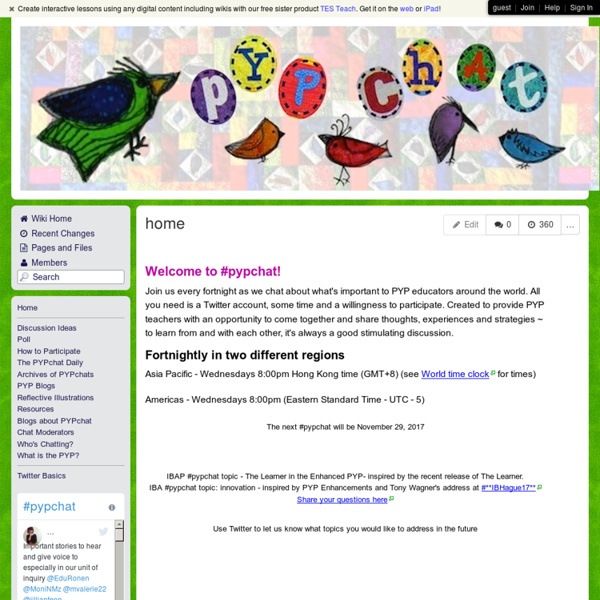



http://pypchat.wikispaces.com/
Related: Professional Learning • PYP RESOURCESThe Best K-12 Education Technology Blogs If it takes a village to raise a child, how many people does it take to train an educator? It’s hard to say, but 50 helping hands seems like a good place to start. In the spirit of community, collaboration and information sharing, EdTech: Focus on K–12 has rounded up 50 ed-tech blogs that we deem must-reads for the K–12 community. We launched our first Must-Read IT list last year to great response so we hope that you all enjoy this year's batch of blogs as well. British Education Experts: 'Empathy Must Be Integrated Into School Curriculum' A recent report entitled “Making Education Work” urges the British government to introduce radical changes into the English education system. This report – prepared by an independent advisory board comprising prominent business leaders and led by preeminent academic Professor Sir Roy Anderson – provides a six-month overview of the British education system and recommends the establishment of a new independent body consisting of teachers, employers, political parties, etc. This cross-party body would be responsible for:
International Baccalaureate® The IB Primary Years Programme (PYP) for children aged 3 - 12 nurtures and develops young students as caring, active participants in a lifelong journey of learning. Through its inquiry-led, transdisciplinary framework, the PYP challenges students to think for themselves and take responsibility for their learning as they explore local and global issues and opportunities in real-life contexts. Learn more about the PYP The PYP curriculum Taught in over 109 countries around the world, the PYP curriculum framework is uniquely adaptable to state and national standards. How we will learn MindShift explores the future of learning in all its dimensions. We examine how learning is being impacted by technology, discoveries about how the brain works, poverty and inequities, social and emotional practices, assessments, digital games, design thinking and music, among many other topics. We look at how learning is evolving in the classroom and beyond.We also revisit old ideas that have come full circle in the era of the over scheduled child, such as unschooling, tinkering, playing in the woods, mindfulness, inquiry-based learning and student motivation.
Two Ways to Explore the News Through Maps When teaching students about current events I have always tried to incorporate maps so that students can make a connection to the places that they are reading about. I do this if the story is about something happening in Africa or something happening twenty miles down the road from our community. Newspaper Map and the Breaking News map are both helpful in showing students the connections between story subjects and their corresponding locations. Newspaper Map is a neat tool for locating and reading newspapers from locations all around the world. JustWondering — Kath Murdoch It’s 1974. I am in Grade 5. I know all the words to 'Seasons in the Sun' and I am in love wth David Cassidy. I have very few memories, but I do remember Miss McNab’s shiny, white leather boots, mini skirt and turtle-neck sweater. I remember a painful week of inexplicable ostracism by my supposed ‘best friends’ andI remember the weekly program, posted each Monday, to help us figure out how to use our time. And when I say ‘posted’ I certainly don't mean in the digital sense.
Technology Front and Center Innovative Instruction | Feature Technology Front and Center A new high school in Texas will combine technology with project-based learning. By Bridget McCrea03/23/11 36 Core Teacher Apps For Inquiry Learning With iPads 36 Core Teacher Apps For Inquiry Learning With iPads The interest in inquiry-based learning seems to ebb and flow based on–well, it’s not clear why it ever ebbs. In short, it is a student-centered, Constructivist approach to learning that requires critical thinking, and benefits from technology, collaboration, resourcefulness, and other modern learning skills that never seem to fall out of favor themselves. Regardless, St Oliver Plunkett Primary School has put together two very useful images that can help you populate your iPad–or classroom of iPads–with apps that support both inquiry-based learning (the second image below), and a more general approach to pedagogy based on Apple’s uber-popular tablet (the top image). The original pdf for the first file can be downloaded here. 36 Core Teacher Apps For Inquiry Learning With iPads; image attribution St.